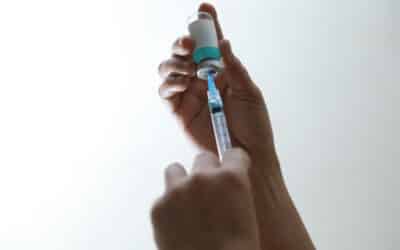Andropause, often called male menopause, affects millions of men as they age, leading to symptoms that can significantly impact their quality of life. This guide explores the causes, symptoms, and treatment options for andropause, offering insights into how men can address declining testosterone levels through medical intervention and lifestyle changes.
What is andropause?
Andropause, commonly referred to as male menopause or late-onset hypogonadism (LOH), is characterized by a gradual decline in testosterone levels that typically begins in middle age. Unlike female menopause, which occurs over a finite period, andropause develops slowly over time, with testosterone levels declining at approximately 1% per year (Mayo Clinic).
Andropause is a natural part of the aging process in men, and medical professionals do not consider it a disease on its own. Low testosterone (Low-T) levels without accompanying symptoms are not necessarily a cause for concern but, when combined with symptoms, may warrant medical attention.
The medical community is increasingly recognizing male menopause as an important aspect of men’s health that can significantly impact quality of life. While androgen deficiency syndromes can occur at any age, andropause refers explicitly to the age-related testosterone decline experienced by aging males.
Symptoms and effects of andropause

TeAs testosterone levels decline during andropause, men may experience a range of physical, sexual, and emotional symptoms that impact daily life. These symptoms often develop gradually and may initially feel like normal aging, making andropause challenging to recognize without proper assessment. Andropause comes with a handful of common symptoms, including:
- Decreased sex drive or libido
- Erectile dysfunction
- Difficulty concentrating
- Decreased energy
- Depression
- Reduced muscle mass and strength
- Increased body fat
- Decreased bone density
- Reduced vitality and depressed mood
The severity and combination of symptoms vary among males, with some men experiencing minimal effects while others face substantial challenges. Your medical provider can run blood tests to measure total testosterone concentrations and free testosterone levels. These tests will confirm whether or not your testosterone levels fall below the normal range, potentially indicating androgen deficiency that could benefit from medical intervention.
Causes and risk factors
The primary cause of andropause is the natural age-related decline in testosterone production that occurs in aging males. Testosterone levels typically begin to decrease in middle age, with studies, including the European Male Aging Study, confirming a steady decline in overall bodily functions as men age (National Library of Medicine).
Several modifiable and non-modifiable risk factors can accelerate testosterone decline or exacerbate androgen deficiency. Identifying these factors is essential for both prevention and effective management of andropause symptoms.
- Aging: Testosterone levels decline with age, with a steady decline of about 1% per year.
- Obesity: A high body mass index (BMI) is associated with low testosterone levels.
- Sleep Apnea: Untreated sleep apnea can contribute to low testosterone levels.
- Medical Conditions: Hypothyroidism, diabetes, and high blood pressure can potentially lead to low testosterone.
- Medications: Certain medications, such as steroids and opioids, can lower testosterone levels.
Poor sleep quality and chronic stress can disrupt normal hormone production and contribute to secondary hypogonadism (National Library of Medicine). Excessive alcohol consumption has also been linked to testosterone deficiency, creating a potentially reversible cause of low testosterone levels.
Diagnosis and physical examination

Testosterone boosters are a supplementary substance that helps increase testosterone levels in a man’s blood. Traditionally, testosterone boosters were only available in the form of harmful Diagnosing andropause requires medical evaluation through multiple blood tests. These tests measure your total testosterone concentrations, free testosterone levels, and sex hormone-binding globulin (SHBG).
Medical professionals will also conduct a physical examination and collect a detailed medical history. Along with blood tests, your medical history will help identify symptoms suggestive of testosterone deficiency, as regular testosterone readings can vary significantly from man to man.
The Endocrine Society guidelines emphasize the importance of patient outcomes when considering treatment options for men with low testosterone. These guidelines suggest offering testosterone therapy on an individualized basis—only after explicit testing and discussion of the potential risks and benefits.
Impact on men’s health
Andropause impacts multiple aspects of men’s health that extend beyond the initial symptoms. These changes affect physical and mental well-being in ways that significantly reduce quality of life. Untreated or unaddressed andropause can lead to:
- Increased risk of cardiovascular disease
- Increased risk of osteoporosis and low trauma fractures
- Affected cognitive function and depressed mood
- Diminished sexual function and reduced fertility
Being aware of these health impacts is crucial for middle-aged men who are considering whether to address their androgen deficiency through lifestyle changes or medical intervention.
Treatment options for men with low testosterone
Several evidence-based approaches exist for addressing testosterone deficiency in aging males. The right treatment plan depends on symptom severity, overall health status, and individual preferences.
- Testosterone replacement therapy (TRT): Helps to restore normal testosterone levels and alleviate symptoms like decreased muscle mass, reduced energy, and sexual dysfunction. Men can undergo TRT via oral medication, self-injections, gels, or patches.
- Hormone replacement therapy (HRT): Recommended for men with hypogonadism, often administered through gels, injections, patches, or pellets in divided doses. HRT addresses a broader spectrum of hormone imbalances, whereas TRT only focuses on testosterone.
- Lifestyle changes: Weight loss, regular exercise to stimulate growth, stress reduction, improved sleep quality, and reduced alcohol consumption naturally support hormone production.
The right approach will require personalized guidance from healthcare providers who specialize in men’s sexual medicine. A comprehensive evaluation and treatment plan should address physical and emotional symptoms while weighing the potential benefits against cardiovascular risk.
Benefits of treatment for older men

When medical providers appropriately prescribe testosterone therapy for older men with genuine testosterone deficiency, several significant improvements in health and quality of life often follow. Treatment addresses multiple aspects of andropause simultaneously, providing relief from both physical and emotional symptoms, including:
- Sexual function and libido restoration
- Muscle mass and strength enhancement
- Bone density preservation
- Cognitive function and mood stability
- Overall quality of life optimization
At Huddle Men’s Health, we know that testosterone treatment requires careful consideration of each patient’s desired outcomes, health concerns, and symptoms. Our individualized care approach focuses on comprehensive evaluation and personalized treatment plans that address the unique needs of each aging male experiencing androgen deficiency.
Risks and contraindications
While testosterone replacement therapy offers benefits for men with symptomatic androgen deficiency, there are some health conditions that make TRT risky or impractical. Common risk factors and complications include:
- Cardiovascular disease
- Prostate cancer
- Breast cancer
- Blood clots
- Prostate or breast cancer
These potential complications highlight why the Endocrine Society guidelines recommend offering testosterone therapy only on an individualized basis after explicit discussion of the potential risks and benefits (Endocrine Society).
Monitoring and follow-up care for the aging male
To ensure the safety and efficacy of your androgen therapy, your medical providers must properly monitor dosage and outcomes. They should order regular blood tests to measure total testosterone concentrations and free testosterone levels. These results will guide dosage adjustments for optimal results while minimizing potential risks.
Physical examinations focusing on prostate health, cardiovascular function, and overall well-being are fundamental to follow-up care. Men receiving androgen replacement therapy should maintain regular appointments with their providers to discuss any changes in symptoms or the emergence of side effects, such as oily skin, sleep apnea, or elevated prolactin levels. You will also engage in regular cancer screenings for routine prevention.
Low testosterone levels and quality of life
Androgen deficiency can dramatically impact an aging male’s quality of life, causing physical, sexual, and even emotional symptoms. Many men report that decreased energy, poor concentration, and reduced ability to maintain physical and mental performance significantly affect their daily functioning and relationships.
Addressing low testosterone levels through either medical treatment or lifestyle modifications can restore a sense of well-being and vitality to middle-aged men experiencing andropause, leading to substantial enhancements in overall quality of life.

Rediscover your vitality with Huddle Men’s Health
Andropause represents a significant but often overlooked aspect of men’s health that affects countless aging men with symptoms ranging from sexual dysfunction to bone health concerns. Low testosterone levels impact multiple body systems and can increase vulnerability to age-related conditions, including cardiovascular disease, osteoporosis, and cognitive decline.
Take control of your health and vitality today by scheduling a comprehensive evaluation with Huddle Men’s Health. Our specialists understand the complex nature of androgen deficiency syndromes, and we provide evidence-based, individualized care to help you navigate the challenges of andropause and rediscover your optimal quality of life through appropriate treatment options and lifestyle modifications.
FAQs
What is andropause, and why does it happen?
Andropause, also known as male menopause, occurs when testosterone levels decline as men age. This gradual process typically begins in the 40s and triggers symptoms as a result of reduced testosterone production from the pituitary gland.
As hormone levels decrease, men may experience changes in sexual function, muscle mass, energy levels, and overall well-being. Unlike female menopause, which happens suddenly, andropause develops over time, leading to symptoms that can affect both physical and emotional health.
What are the signs of andropause?
Common symptoms of andropause include low testosterone levels, erectile dysfunction, poor concentration, and decreased energy. Many men also notice increased body fat, reduced muscle mass, and mood changes, such as depressed mood or irritability. Some may experience sleep disturbances, hot flushes, or a reduced ability to maintain physical endurance. While symptoms vary, declining testosterone levels can impact quality of life and overall health.
How is andropause diagnosed?
Doctors diagnose andropause through blood tests that measure total testosterone concentrations, free testosterone levels, and sex hormone-binding globulin (SHBG). These tests determine if testosterone levels fall below the normal range.
Doctors may also perform a physical examination to assess symptoms suggestive of testosterone deficiency. If low testosterone levels are confirmed, a doctor may discuss treatment options, such as testosterone replacement therapy (TRT) or lifestyle modifications.
Can testosterone replacement therapy help with andropause?
Testosterone therapy can be effective in alleviating symptoms of andropause by helping to restore sexual function, muscle mass, and energy levels. However, testosterone replacement carries potential risks, including cardiovascular disease, prostate cancer, and sleep apnea. Before starting testosterone therapy, it’s essential to consult a healthcare provider to determine whether the benefits outweigh the risks based on individual health conditions.
What are natural ways to manage andropause symptoms?
While testosterone supplementation can help, lifestyle adjustments also improve hormone production and alleviate symptoms. Regular exercise, especially strength training, helps stimulate growth and maintain muscle mass.
A healthy diet supports testosterone levels and prevents weight gain while reducing alcohol consumption and improving sleep quality, which can enhance overall health. Managing stress and maintaining a balanced routine can further support hormone levels and help men feel more energized as they age.




